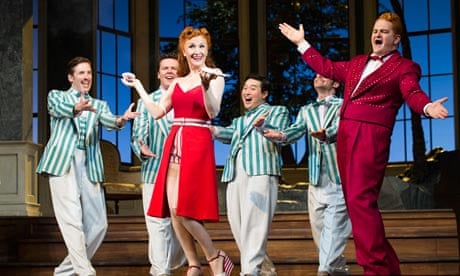Katharina Thoma's annoying Glyndebourne production of Ariadne auf Naxos relocates Strauss's elusive opera about opera to a British country house during the second world war. The transposition derives from Thoma's rather curious elision of the work with the history of Glyndebourne itself. Strauss's preoccupation with operatic patronage, creation and performance, maps to some extent on to the circumstances of the festival's creation in the 1930s. More pertinent to Thoma's purpose, however, is the fact that British country houses were used in wartime either as nursing homes or, as at Glyndebourne, to house refugees. Thoma brings the two historical strands together, though the combination proves intractable.
Things begin, as they should, with preparations for a private performance of an opera in a posh salon converted into a theatre. But the unusual agitation of Kate Lindsey's neurotic Composer, the presence of army and RAF personnel in the building, and the gathering darkness outside create a palpable sense of unease. As artistic plans drift towards chaos, an air raid begins, bombs fall and the house is soon in flames.
The second half, however, departs completely from Strauss, whose intention was that we should now watch the opera we have already seen in preparation. Instead, the ruined house has been turned into a hospital where we find the shattered protagonists being treated for trauma, mental or physical.
The Nymphs have become nurses. Soile Isokoski's depressive Ariadne attempts suicide with drugs from the medicine cabinet, which has neglectfully been left open. Bacchus (Sergey Skorokhodov) is a wounded fighter pilot. Laura Claycomb's Zerbinetta, far from celebrating the fluidity of female sensuality, is a predatory sex addict in need of straitjacketing. Thoma's aim is apparently to heighten our awareness of the score's intensity. In fact, by presenting everyone as damaged, she has obliterated the idea of parallel narratives – one tragic, one comic – on which its impact crucially depends.
Musically, too much of the first night was unremarkable. Claycomb, Isokoski and Skorokhodov were all in worryingly poor voice; one hopes they improve. Lindsey steals the show with her gleaming tone, dramatic subtlety and palpable commitment. Thomas Allen and Wolfgang Ablinger-Sperrhacke make excellent sparring partners as the Music and Dancing Masters, while the fine quartet for the Harlequinade get to do some nifty dance routines. Conductor Vladimir Jurowski favours swift speeds and is short on wit. Orchestrally, it's beautiful.






Comments (…)
Sign in or create your Guardian account to join the discussion